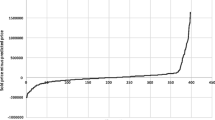Abstract
Foreclosure properties sold at Japanese judicial auctions are delivered to buyers with an unclear title when occupants exist, because the foreclosure laws protect occupants from compulsory execution of auctions. The existence of occupants theoretically affects the auction price through two channels. First, it affects the reserve price, and this changes in auction price. Second, the number of bidders changes in response to changes in the reserve price that is controlled by occupants, and this changes the auction price. Using data from the Osaka District Court, we empirically find that the existence of occupants in properties reduces the auction price through two channels.

Similar content being viewed by others
Notes
Tomura (2007) presents a dynamic general economic equilibrium model that captures endogenous fluctuations in total factor productivity (TFP) in response to credit market shocks. In his model, TFP is defined as the average productivity of land. He shows that restrictions on liquidating collateral assets under the foreclosure laws caused negative credit market shocks and an endogenous fall in the TFP growth rate in Japan in the 1990s.
Mayer (1998) also shows real estate properties sold in auctions appear to sell at a discount relative to negotiated sales. His results are consistent with the theoretical prediction of his earlier work (Mayer 1995) that the auction discount increases in downturns when a seller trades off a longer expected selling time in a search market against an immediate auction sale.
Note that the so-called short-term leasehold and long-term leasehold do not depend on the time horizon. Instead, they depend on the timing of lease inception and settlement of mortgage.
Civil law provides rights over property and contracts between citizens in Japan. Fundamental rights associated with real estate, such as property rights, lease rights, and mortgages, are included in civil law.
Civil execution law is one of the laws that achieves rights that are provided by civil law. Civil execution law provides rights of compulsory execution, repossession, and foreclosure.
We do not consider the optimal strategy of a seller (court). In contrast, McAfee et al. (2002) show the optimal reserve price using the common-value model, and then empirically test the real estate auction data.
Ooi et al. (2006) expect that a greater number of auctions reduces the competition among bidders for any given property, thereby reducing bids and the selling price.
Toda et al. (1998) estimated the auction price of apartments in Moscow. They estimated a hedonic function by maximum likelihood using data of apartments not actually sold.
Vacant includes a property that is occupied by a mortgagor. As mentioned in Section “The Judicial Foreclosure Process”, his or her right of continued residence is not protected by the laws.
The foreclosure laws of Japan were amended in 2003 as mentioned in Section “The Judicial Foreclosure Process”, and enforcement commenced on April 1, 2004. Therefore the data set in 2004 includes the properties with short-term leasehold.
The 1998 amendments of the foreclosure laws enforcement commenced on December 12, 1998. Therefore auctions in 1997 and 1998 are included in Failure before.
References
Allen, M. T., & Swisher, J. (2000). An analysis of the price formation process at a HUD auction. Journal of Real Estate Research, 20(3), 279–298.
Mayer, C. J. (1995). A model of negotiated sales applied to real estate auctions. Journal of Urban Economics, 38(1), 1–22. doi:10.1006/juec.1995.1020.
Mayer, C. J. (1998). Assessing the performance of real estate auctions. Real Estate Economics, 26(1), 41–68. doi:10.1111/1540-6229.00737.
McAfee, R. P., Quan, D. C., & Vincent, D. R. (2002). How to set minimum acceptable bids, with an application to real estate auctions. Journal of Industrial Economics, 50(4), 391–416. doi:10.1111/1467-6451.00183.
Ong, S. E., Lusht, K., & Mak, C. Y. (2005). Factors influencing auction outcomes: bidder turnout, auction houses and market conditions. Journal of Real Estate Research, 27(2), 177–191.
Ooi, J. T. L., Sirmans, C. F., & Turnbull, G. K. (2006). Price formation under small numbers competition: evidence from land auctions in Singapore. Real Estate Economics, 34(1), 51–76. doi:10.1111/j.1540-6229.2006.00159.x.
Quan, D. C. (1994). Real estate auctions: a survey of theory and practice. Journal of Real Estate Finance and Economics, 9(1), 23–94. doi:10.1007/BF01153587.
Saita, Y. (2003). Land prices in the Tokyo metropolitan area: a hedonic analysis of judicial auction prices. Bank of Japan: Working Paper Series, No. 03-E-4.
Toda, Y., Nozdrina, N., & Maddala, G. S. (1998). The auction price of apartments in Moscow: hedonic estimation in disequilibrium. Economics of Planning, 31(1), 1–14. doi:10.1023/A:1003158231050.
Tomura, H. (2007). Firms dynamics, bankruptcy laws and total factor productivity. Bank of Canada: Working Paper 2007-17.
Acknowledgements
We would like to thank Hideki Mizukami, Yasushi Toda, Fukuju Yamazaki, and seminar participants at the JLEA conference in Tokyo for their valuable comments and suggestions. We also acknowledge the helpful comments of anonymous reviewers. All remaining errors are the sole responsibility of the authors. The views expressed here solely those of the authors and do not reflect any of the institutions they belong to.
Author information
Authors and Affiliations
Corresponding author
Rights and permissions
About this article
Cite this article
Idee, T., Iwata, S. & Taguchi, T. Auction Price Formation with Costly Occupants: Evidence Using Data from the Osaka District Court. J Real Estate Finan Econ 42, 84–98 (2011). https://doi.org/10.1007/s11146-009-9169-z
Published:
Issue Date:
DOI: https://doi.org/10.1007/s11146-009-9169-z




